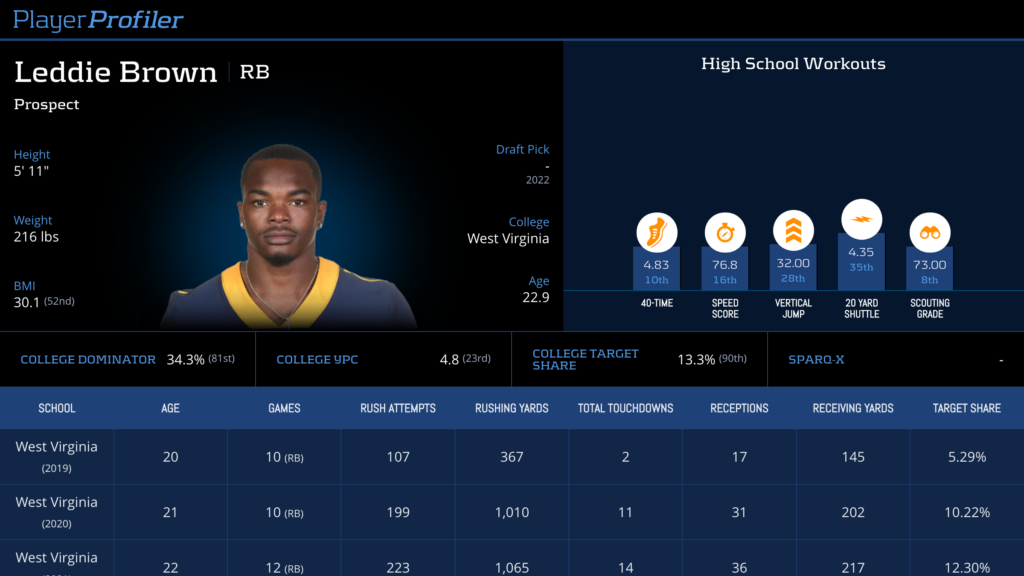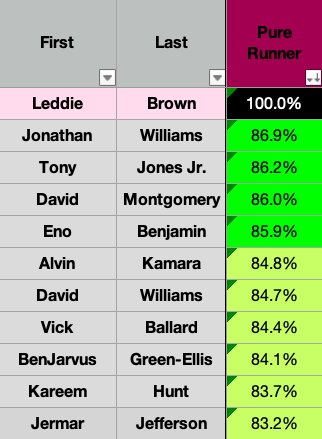West Virginia’s Leddie Brown is the next subject in a series in which I evaluate 2022 rookie running backs solely on their ability to run the ball. The Breakout Finder installments can be found here. The PlayerProfiler installments can be found here. If you happened to already catch those and don’t need a refresher on my methodology, feel free to skip to the player-focused analysis.

West Virginia’s Leddie Brown is one of the more interesting under-the-radar running back prospects in this year’s class. He was productive at a Power 5 school. He’s not a fifth-year senior. And he has the requisite size and receiving chops. Let’s see how his rushing efficiency numbers stack up.
The Metrics
Leddie Brown handled a respectable workload on the ground during his four years as a Mountaineer. He tallied a 75th-percentile (among backs drafted since 2007) total of 620 carries. On those attempts, he gained almost 3000 yards. While his raw 4.66 yards per carry is just a 23rd-percentile mean, he did average 0.61 more yards per carry than other West Virginia running backs. That YPC+ number is in the 55th-percentile, and Brown’s career mark in Chunk Rate+ is even more impressive. Relative to a decent running back group that averaged a 3.03-star rating as high school recruits (43rd-percentile), Brown ripped off chunk gains of 10+ yards at a 3.61-percent greater clip, a mark in the 78th-percentile.

Brown was not particularly impressive as an open-field runner. He converted just 22.6-percent of those 10-yard chunk runs into breakaways of 20 or more yards (15th-percentile). However, if I’m choosing between a guy whose positive team-relative efficiency is fueled by splash plays or a guy who is outdoing his teammates based on his ability to manipulate linebackers and choose the right hole at the line of scrimmage, give me the second guy. Obviously we’d prefer our running backs to have it all. But the particular kind of efficiency profile that Brown has is indicative of a guy who possesses the necessary nuance and refined skill as a ballcarrier to transition to the next level. I’d rather that than a guy who is efficient due to athleticism-fueled breakaway runs that are going to be harder to come by in the NFL.
Relative Success Rate
That suggested ability to win at the point of attack is backed up by Brown’s consistency relative to his teammates. A newer metric I’ve been collecting data on and using to evaluate these rookie running backs is Relative Success Rate. Which is similar to Box-Adjusted Efficiency Rating in that it adjusts efficiency using the context of the respective box counts that players were carrying the ball against. While BAE Rating uses a comparison of yards per carry versus each box count to a player’s teammates, Relative Success Rate compares a player’s Success Rate against each box count to his teammates’ collective Success Rate against those box counts.
Success Rate, as defined by Pro Football Outsiders, is “a measure of running back consistency based on the percentage of carries where the player gains 40-percent of needed yards on first down, 60-percent of needed yards on second down, or 100-percent of needed yards on third or fourth down.”
While controlling for situation, Success Rate assigns a binary success/failure tag to each rushing attempt. It then finds the percentage of carries on which a running back succeeds. Adding box count data context, we find Brown succeeded on 5.9-percent more of his carries than other Mountaineer backs. I don’t have Relative Success Rate data on enough players to tell you how that compares historically. But it’s a better teammate-relative number than Travis Etienne, Jonathan Taylor, and Cam Akers posted in their college careers. It also exceeds the marks posted by guys like Breece Hall and Isaiah Spiller (naturally) in this year’s class.
Brown’s positive team-relative efficiency was accomplished while running into boxes that were 0.13 defenders heavier than those his teammates faced (71st-percentile). And his career BAE Rating is an almost-average 114.6-percent (45th-percentile).
Rushing Efficiency Score and Comps
Based on all of the non-BAE metrics that I’ve touched on here (in addition to overall team quality, offensive line play, rushing volume, and strength of opponent), Leddie Brown earns a 55.4 out of 100 in my running back model’s composite Rushing Efficiency Score. In a different composite score that does use the box count metrics, he earns a 50.7 out of 100. While not incredible, I believe he is a quality runner of the football.
Brown is likely to be 216-pounds and just shy of 5-11 at the Combine. Given his relatively poor showing as a breakaway runner, we’ll assume he runs a 4.60 40-yard dash. Using the same metrics that make up the Rushing Efficiency composite, in addition to physical measurables, the historical prospects that my comp machine views as most similar to Brown from a “pure runner” perspective are the following:

There are some interesting names here. He wasn’t the tackle-breaker in college that David Montgomery, Alvin Kamara, or Kareem Hunt were (per PFF’s Missed Tackles Forced). But despite stylistic differences, he was similarly efficient to those players.
Last Word
Ultimately, Leddie Brown has just as good a data-based rushing profile as several more-hyped players in this class; such as Jerome Ford, Dameon Pierce, Kyren Williams, and even Breece Hall. He also boasts solid size, quality receiving chops, and a legitimate production profile. I’m really not sure what I’m missing with this guy. The 2022 NFL Draft is starved for running backs with complete skillsets. Brown is an oasis in the middle of that desert.


